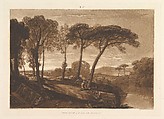The Temple of Minerva Medica, part V, plate 23 from "Liber Studiorum"
Designed and etched by Joseph Mallord William Turner British
Engraver Robert Dunkarton British
Publisher Joseph Mallord William Turner British
Not on view
Turner distilled his ideas about landscape In "Liber Studiorum" (Latin for Book of Studies), a series of seventy prints plus a frontispiece published between 1807 and 1819. To establish the compositions, he made brown watercolor drawings, then etched outlines onto copper plates. Professional engravers usually developed the tone under Turner's direction, and Dunkrton here added mezzotint to detail a vista redolant of the Roman campagna with a ruined nymphaeum in the distance. Turner did not publish a title, but referred to the image as "Minerva Medica" in his notes. The intriguing presence of an oriental figure kneeling under the trees led later scholars to call the print "Hindoo Worshipper," and "Hindoo Devotions." The letters "EP" in the upper margin likely stand for Elevated Pastoral, and were applied by Turner to landscapes within the set that echo the Arcadian sensibility of Claude.
Due to rights restrictions, this image cannot be enlarged, viewed at full screen, or downloaded.


